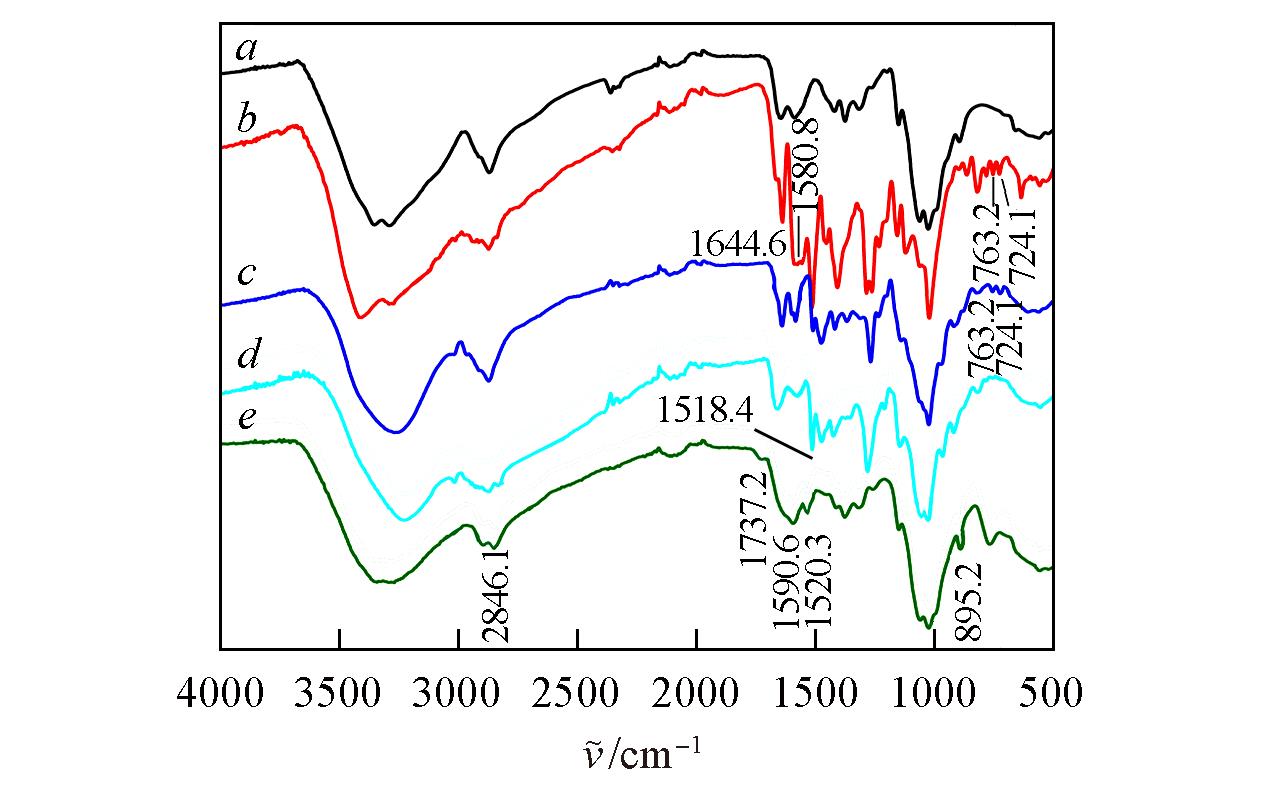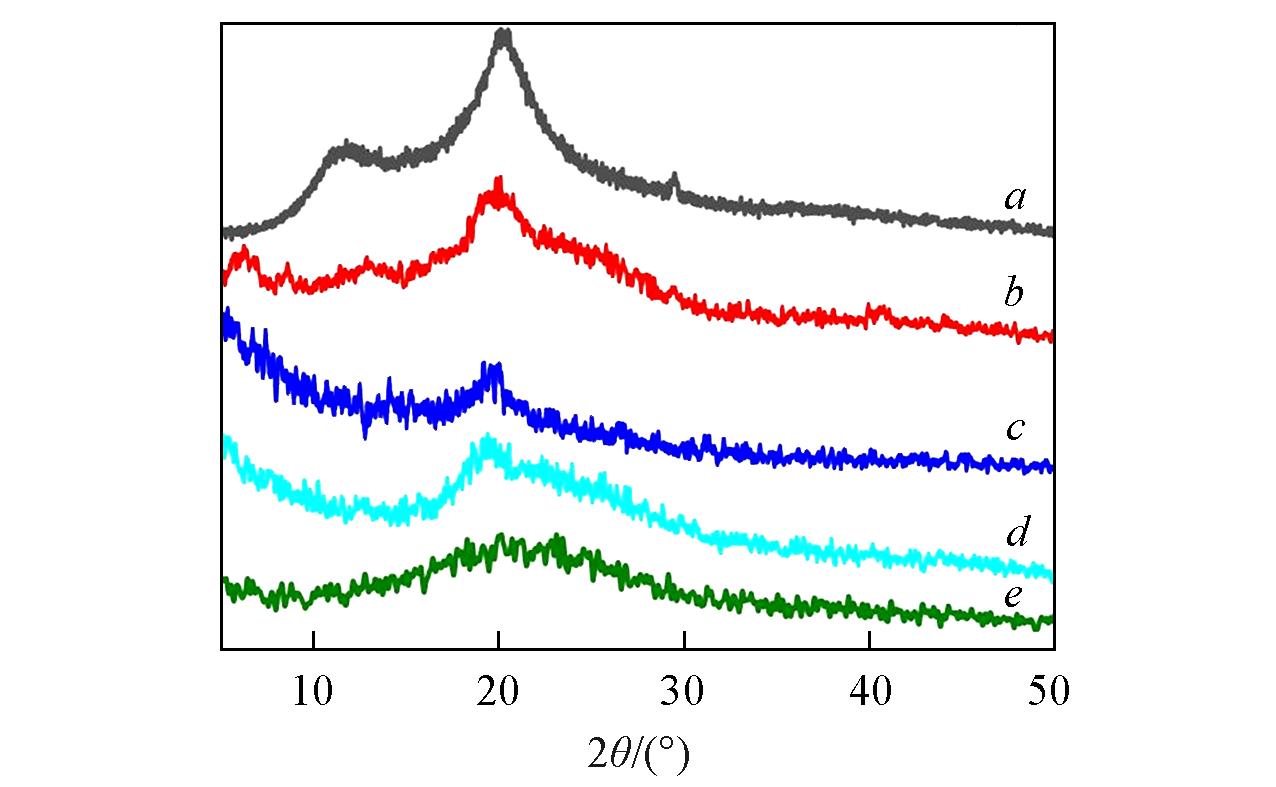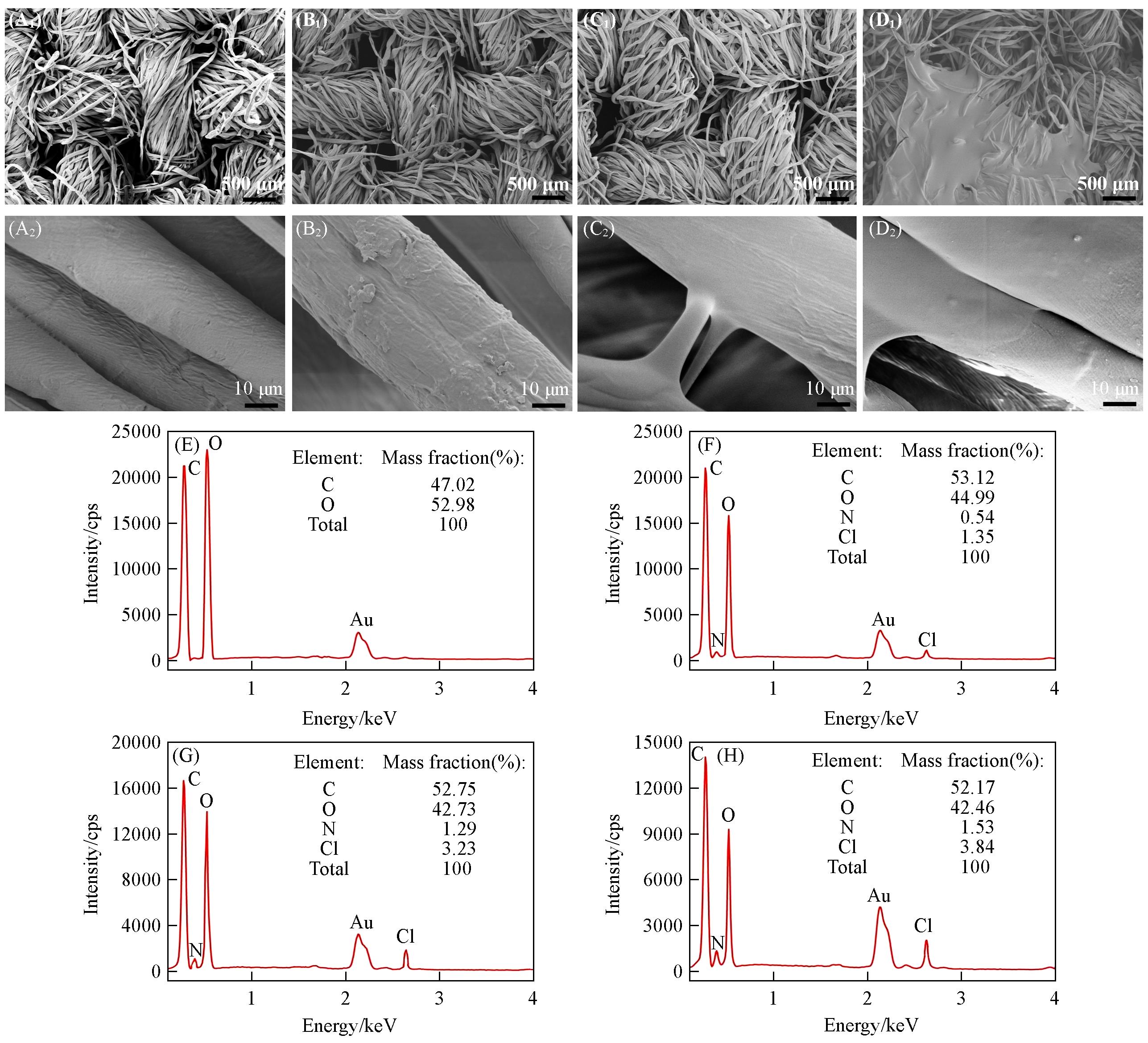

高等学校化学学报 ›› 2024, Vol. 45 ›› Issue (3): 20230375.doi: 10.7503/cjcu20230375
周晓龙1, 汪瑞琪1, 陈国丽1, 郭文明1, 陈飞1, 周炎2, 孙立德2, 汤大保2, 许云辉1( )
)
收稿日期:2023-08-23
出版日期:2024-03-10
发布日期:2024-01-23
通讯作者:
许云辉
E-mail:xuyunhui@ahau.edu.cn
基金资助:
ZHOU Xiaolong1, WANG Ruiqi1, CHEN Guoli1, GUO Wenming1, CHEN Fei1, ZHOU Yan2, SUN Lide2, TANG Dabao2, XU Yunhui1( )
)
Received:2023-08-23
Online:2024-03-10
Published:2024-01-23
Contact:
XU Yunhui
E-mail:xuyunhui@ahau.edu.cn
Supported by:摘要:
通过香草醛与壳聚糖C2位氨基形成席夫碱以保护氨基, 然后在C6位羟基上接枝2,3-环氧丙基三甲基氯化铵(GTA)季铵盐, 利用稀HCl乙醇溶液脱除席夫碱后合成出O-季铵盐壳聚糖(O-HACC), 再用KIO4将 O-HACC中C2和C3位的部分基团选择性地氧化为醛基, 制备出能与纤维反应结合且具有双重抗菌活性的 O-季铵盐氧化壳聚糖(O-HAOCC), 随后接枝棉织物得到O-HAOCC改性棉织物. 傅里叶变换红外光谱(FTIR)、 X射线衍射(XRD)、 氢核磁共振波谱(1H NMR)、 扫描电子显微镜(SEM)和差示扫描量热分析(DSC)等结果表明, O-HAOCC分子中保留了氨基, 同时引入了季铵盐结构和活性醛基, 结晶形态被破坏, 热稳定性降低. 测试结果表明, 氧化3 h的O-HAOCC的水溶性高达237 g/L, 2,2'-联氮双(3-乙基苯并咪唑-6-磺酸)二铵盐(ABTS)自由基清除率在40 min后达到65.58%. 当O-HAOCC质量分数为2%, 反应时间为2 h, 接枝温度为80 ℃时, 改性棉织物的接枝率为9.84%. O-HAOCC改性棉织物对金黄色葡萄球菌和大肠杆菌的抗菌率分别为98.63%和93.38%, 水洗50次后的抗菌率仍在90.75%以上, 可应用于抗菌纺织服装、 家纺面料和医疗卫生品等领域.
中图分类号:
TrendMD:
周晓龙, 汪瑞琪, 陈国丽, 郭文明, 陈飞, 周炎, 孙立德, 汤大保, 许云辉. O-季铵盐氧化壳聚糖的合成及对棉织物的抗菌整理. 高等学校化学学报, 2024, 45(3): 20230375.
ZHOU Xiaolong, WANG Ruiqi, CHEN Guoli, GUO Wenming, CHEN Fei, ZHOU Yan, SUN Lide, TANG Dabao, XU Yunhui. Synthesis of O-quaternary Ammonium Salt-oxidized Chitosan and Its Antibacterial Finishing for Cotton Fabric. Chem. J. Chinese Universities, 2024, 45(3): 20230375.

Fig.1 Effects of different reaction conditions on the degree of substitution of quaternary ammonium salt for chitosan(A) w(NaOH)=0.2%, reaction temperature was 80 ℃, reaction time was 3 h; (B) w(NaOH)=0.2%, n(Schiff-CTS)∶n(GTA)=1∶3, reaction time was 3 h; (C) n(Schiff-CTS)∶n(GTA)=1∶3, reaction temperature was 80 ℃, reaction time was 3 h; (D) w(NaOH)=0.2%, n(Schiff-CTS)∶n(GTA)=1∶3, reaction temperature was 80 ℃.

Fig.3 FTIR spectra of products at each synthesis stage of O⁃HAOCCa. CTS; b. Schiff-CTS; c. Schiff-HACC-0.2-1/3-80-3; d. O-HACC-0.2-1/3-80-3; e. O-HAOCC-4-3.

Fig.4 XRD patterns of products at each synthesis stage of O⁃HAOCCa. CTS; b. Schiff-CTS; c. Schiff-HACC-0.2-1/3-80-3; d. O-HACC-0.2-1/3-80-3; e. O-HAOCC-4-3.
| Index | DS of O⁃HACC(%) | Oxidation time of O⁃HAOCC a | ||||||
|---|---|---|---|---|---|---|---|---|
| 34.81 | 58.76 | 75.72 | 86.35 | 1 | 3 | 6 | 8 | |
| Water solubility b /(g·L-1) | 26 | 65 | 142 | 176 | 188 | 237 | 279 | 261 |
| 10‒4 Mvc | 62.7 | 56.8 | 67.2 | 59.1 | 38.5 | 20.3 | 13.7 | 10.4 |
Table 1 Water solubility and molecular weight of O-HACC with different DS and O-HAOCC after oxidation with 4 g/L KIO4 for different time
| Index | DS of O⁃HACC(%) | Oxidation time of O⁃HAOCC a | ||||||
|---|---|---|---|---|---|---|---|---|
| 34.81 | 58.76 | 75.72 | 86.35 | 1 | 3 | 6 | 8 | |
| Water solubility b /(g·L-1) | 26 | 65 | 142 | 176 | 188 | 237 | 279 | 261 |
| 10‒4 Mvc | 62.7 | 56.8 | 67.2 | 59.1 | 38.5 | 20.3 | 13.7 | 10.4 |

Fig.8 ABTS·+ radical scavenging activity(A) and UV absorption spectra(B) of ABTS solution after 40 min reaction with CTS(a), O⁃HACC⁃0.2⁃1/3⁃80⁃3(b), O⁃HAOCC⁃4⁃1(c), O⁃HAOCC⁃4⁃3(d) and O⁃HAOCC⁃4⁃6(e)(B) f. control. The inset shows the color change of ABTS·+ solution(f) after 40 min reaction with CTS(a), O-HACC-0.2-1/3-80-3(b), O-HAOCC-4-1(c), O-HAOCC-4-3(d) and O-HAOCC-4-6(e).

Fig.11 SEM images(A1—D1, A2—D2) and EDS analysis(E—H) of cotton fabric(A1, A2, E) and O⁃HAOCC modified cotton fabric with graft ratio of 4.81%(B1, B2, F), 9.84%(C1, C2, G) and 10.95%(D1, D2, H)
| Sample | Graft ratio(%) | Breaking strength/N | Capillary effect/(cm·30 min‒1) | Whiteness(%) | Wrinkle recovery angle/(°) |
|---|---|---|---|---|---|
| Origin cotton fabric | 0 | 423.68 | 8.79 | 81.61 | 124.22 |
| Modified cotton fabric | 4.81 | 447.15 | 10.84 | 70.29 | 140.62 |
| Modified cotton fabric | 9.84 | 478.23 | 12.01 | 63.34 | 167.28 |
Table 2 Changes in wearability of O-HAOCC modified cotton fabric
| Sample | Graft ratio(%) | Breaking strength/N | Capillary effect/(cm·30 min‒1) | Whiteness(%) | Wrinkle recovery angle/(°) |
|---|---|---|---|---|---|
| Origin cotton fabric | 0 | 423.68 | 8.79 | 81.61 | 124.22 |
| Modified cotton fabric | 4.81 | 447.15 | 10.84 | 70.29 | 140.62 |
| Modified cotton fabric | 9.84 | 478.23 | 12.01 | 63.34 | 167.28 |
| Wearability | Modified cotton fabric with graft ratio of 9.84% | Ref.[ | Ref.[ |
|---|---|---|---|
| Improvement effect of breaking strength | 12.88% | -2.77% | — |
| Improvement effect of wrinkle recovery angle | 34.66% | 31.07% | — |
| Improvement effect of capillary effect | 36.63% | — | — |
| Antibacterial rate(Antibacterial durability against laundry) | ≥93.38%(≥90.76%) | — | — |
Table 3 The wearability of different materials
| Wearability | Modified cotton fabric with graft ratio of 9.84% | Ref.[ | Ref.[ |
|---|---|---|---|
| Improvement effect of breaking strength | 12.88% | -2.77% | — |
| Improvement effect of wrinkle recovery angle | 34.66% | 31.07% | — |
| Improvement effect of capillary effect | 36.63% | — | — |
| Antibacterial rate(Antibacterial durability against laundry) | ≥93.38%(≥90.76%) | — | — |
| Number of washing time | ||||||
|---|---|---|---|---|---|---|
| Sample | 0 | 20 | 50 | |||
| S. aureus | E. coli | S. aureus | E. coli | S. aureus | E. coli | |
| Raw cotton fabric | 2.16×106(0) | 4.29×106(0) | — | — | — | — |
| Modified cotton fabric with graft ratio of 4.81% | 1.28×105(94.07) | 3.32×105(92.26) | 1.72×105(92.04) | 3.96×105(90.77) | 2.07×105(90.42) | 4.62×105(89.23) |
| Modified cotton fabric with graft ratio of 9.84% | 2.96×104(98.63) | 2.84×105(93.38) | 1.06×105(95.09) | 3.55×105(91.72) | 1.33×105(93.86) | 3.96×105(90.76) |
Table 4 Survival colony count(CFU/mL) and antibacterial rate(%, in parentheses) of cotton fabric before and after O-HAOCC modification
| Number of washing time | ||||||
|---|---|---|---|---|---|---|
| Sample | 0 | 20 | 50 | |||
| S. aureus | E. coli | S. aureus | E. coli | S. aureus | E. coli | |
| Raw cotton fabric | 2.16×106(0) | 4.29×106(0) | — | — | — | — |
| Modified cotton fabric with graft ratio of 4.81% | 1.28×105(94.07) | 3.32×105(92.26) | 1.72×105(92.04) | 3.96×105(90.77) | 2.07×105(90.42) | 4.62×105(89.23) |
| Modified cotton fabric with graft ratio of 9.84% | 2.96×104(98.63) | 2.84×105(93.38) | 1.06×105(95.09) | 3.55×105(91.72) | 1.33×105(93.86) | 3.96×105(90.76) |
| 1 | Saini S., Gupta A., Singh N., Sheikh J., J. Ind. Eng. Chem., 2020, 82, 138—143 |
| 2 | Bakshi P. S., Selvakumar D., Kadirvelu K., Kumar N. S., Int. J. Biol. Macromol., 2020, 150, 1072—1083 |
| 3 | Yang X. F., Liu J., Pei Y., Zheng X., Tang K., Energy Environ. Mater., 2020, 3(4), 492—515 |
| 4 | Mo C. X., Xiang L., Chen Y. P., Macromol. Rapid Commun., 2021, 42(10), 2100025 |
| 5 | Negm N. A., Hefni H. H., Abd⁃Elaal A. A., Badr E. A., Abou⁃Kana. M. T., Int. J. Biol. Macromol., 2020, 152, 681—702 |
| 6 | Heydari A., Dušička E., Mičušík M., Sedlák M., Lacík I., Polymer., 2021, 220, 123562 |
| 7 | Yin M., Wang Y., Zhang Y., Ren X., Qiu Y., Huang T. S., Carbohydr. Polym., 2020, 232, 115823 |
| 8 | Ke P., Zeng D., Xu K., Cui J., Li X., ACS Omega., 2020, 5(38), 24700—24707 |
| 9 | Mi Y., Chen Y., Tan W., Zhang J., Li Q., Guo Z., Carbohydr. Polym., 2022, 278, 118970 |
| 10 | Wu Y., Xu W., Li J., Zhong Z., Huang L., Li S., Tan H., Eur. Polym. J., 2024, 202, 112592 |
| 11 | Zhang J., Tan W., Luan F., Yin X., Dong F., Li Q., Guo Z., Polymers, 2018, 10(5), 530 |
| 12 | Ardean, C., Davidescu C. M., Nemeş N. S., Negrea A., Ciopec M., Duteanu N., Negrea P., Seiman D. D., Muntean D., Pharmaceutics, 2021, 13(10), 1639 |
| 13 | Gao Y. L., Zhang H., Wu Y. G., Bai S. X., Zhou L., Liu B., Funct. Polym., 2004, 17(1), 67—71 |
| 高艳丽, 张虹, 吴奕光, 白书欣, 周莉, 刘波. 功能高分子材料, 2004, 17(1), 67—71 | |
| 14 | Liu X., Chen H. X., Chen W. G., J. Zhejiang Sci⁃Tech University, 2009, 26(5), 677—681 |
| 刘新, 陈海相, 陈维国. 浙江理工大学学报, 2009, 26(5), 677—681 | |
| 15 | Lin Y. W., Xu C., Lu C. H., Synth. Chem., 2000, 8(2), 167—170 |
| 林友文, 许晨, 卢灿辉. 合成化学, 2000, 8(2), 167—170 | |
| 16 | Lim S. H., Hudson S. M., Carbohydr. Res., 2004, 339, 313—319 |
| 17 | Shi D. L., Preparation and Inhibition Performance of the Vanillyl⁃chitosan Quaternary Ammonium Salts, Ocean University of China, Qingdao, 2014 |
| 史大历. 香草基壳聚糖季铵盐的制备及其缓蚀性能研究, 青岛: 中国海洋大学, 2014 | |
| 18 | Vold I. M., Christensen B. E., Carbohydr. Res. , 2005, 340(4), 679—684 |
| 19 | Liu Q., Ding B., Hao F. L., Guan C., Li X., Wang H. D., Dyeing, 2016, 42(18), 33—36 |
| 刘群, 丁斌, 郝凤岭, 关昶, 李祥, 王海东. 印染, 2016, 42(18), 33—36 | |
| 20 | Tao R., He X. M., Textile Auxiliaries, 2015, 32(12), 27—32 |
| 陶然, 何雪梅. 印染助剂, 2015, 32(12), 27—32 | |
| 21 | Pan Q. Y., Zhou C., Yang Z. M., He Z. Y., Wang C., Liu Y. H., Song S. H., Gu H., Yu L. J., Li X. R., Qu Y. H., Li P. W., Mod. Food Sci. Technol., 2021, 37(12), 136—144, 204 |
| 潘晴彦, 周闯, 杨子明, 何祖宇, 王超, 刘运浩, 宋书会, 谷会, 于丽娟, 李雪瑞, 屈云慧, 李普旺. 现代食品科技, 2021, 37(12), 136—144, 204 | |
| 22 | Zhang D. S., Preparation of HBP⁃HTC and Its Modification on B. Mori Silk, Soochow University, Suzhou, 2009 |
| 张德锁. HBP⁃HTC的制备及其对真丝(绸)的改性研究, 苏州: 苏州大学, 2009 | |
| 23 | Wang W., Bo S., Li S., Qin W., Int. J. Biol. Macromol., 1991, 13(5), 281—285 |
| 24 | Li X. C., Lin J., Gao Y. X., Chem. Cent. J., 2012, 6, 1—10 |
| 25 | Lim S. H., Hudson S. M., J. Macromol. Sci., 2003, 43(2), 233—269 |
| 26 | Liu Y. Z., Wei X., Zhang Y. Y., Synth. Fiber China, 2011, 40(7), 23—25 |
| 刘玉章, 尉霞, 章媛媛. 合成纤维, 2011, 40(7), 23—25 | |
| 27 | Guo Z., Xing R., Liu S., Zhong Z., Li P., Carbohydr. Polym., 2008, 73(1), 173—177 |
| [1] | 郭昊天, 鲁新环, 孙凡棋, 陶艺元, 段金贵, 张望, 周丹, 夏清华. 纳米球型Mo-MOF材料的调控合成及催化硫醚选择性氧化[J]. 高等学校化学学报, 2023, 44(12): 20230408. |
| [2] | 魏李娜, 彭莉, 朱锋, 顾鹏飞, 顾学红. 中空纤维Au-CeZr/FAU催化膜的制备及在富氢气氛CO选择性氧化反应中的应用[J]. 高等学校化学学报, 2022, 43(10): 20220175. |
| [3] | 李晨晨, 那永. 双功能复合材料g-C3N4/CdS/Ni催化光解水产氢和5-羟甲基糠醛氧化性能[J]. 高等学校化学学报, 2021, 42(9): 2896. |
| [4] | 熊俊宇, 王姗姗, 许颜清, 胡长文. 原子级分散Fe-N-C温和条件下选择性氧化催化特性[J]. 高等学校化学学报, 2020, 41(6): 1262. |
| [5] | 黄晓, 甘汉麟, 彭亮, 顾凤龙. 苯甲醛在光催化反应中氧化还原选择性的理论研究[J]. 高等学校化学学报, 2016, 37(2): 297. |
| [6] | 李旭, 蒋建宏, 韩布兴, 谷惠文, 谢兆凤, 陈兰, 肖圣雄, 李传华, 李爱桃, 李霞, 姚飞虹, 王群, 李强国. 邻香草醛缩组氨酸Schiff碱及其镧配合物的合成与生物活性[J]. 高等学校化学学报, 2015, 36(5): 856. |
| [7] | 蒋建宏, 李旭, 肖圣雄, 谷惠文, 李传华, 杨平, 魏得良, 何笃贵, 李爱桃, 李霞, 姚飞虹, 李强国. 2-{[4-氨基-5-(3,4,5-三甲氧基-苄基)-嘧啶-2-亚胺基]-甲基}-6-甲氧基-苯酚与酵母细胞和牛血清白蛋白的相互作用[J]. 高等学校化学学报, 2014, 35(4): 831. |
| [8] | 王亚丽, 聂艳艳, 蒋育澄, 胡满成, 李淑妮, 翟全国. 基于小分子掺杂及聚电介质模板导向的水溶性聚苯胺的CPO酶促氧化合成及结构性能表征[J]. 高等学校化学学报, 2012, 33(06): 1344. |
| [9] | 石先莹, 马文娟, 韩晓燕, 张文, 吕爱凤, 魏俊发. 固载离子液体刷/过氧磷钨酸盐催化剂催化H2O2选择性氧化硫醚[J]. 高等学校化学学报, 2011, 32(10): 2321. |
| [10] | 庞婧 王同华 李琳 祁文博 张守海 蹇锡高. 不同溶剂对聚醚砜酮基炭膜结构及气体分离性能的影响[J]. 高等学校化学学报, 2011, 32(1): 143. |
| [11] | 李红梅, 周菊发, 祝清超, 曾少华, 魏振玲, 陈耀强, 龚茂初. 共沉淀法制备的CeO2-ZrO2-Al2O3材料及性能[J]. 高等学校化学学报, 2009, 30(12): 2484. |
| [12] | 李峻峰,张利,李钧甫,邹琴,杨维虎,李玉宝 . 香草醛交联壳聚糖载药微球的性能及其成球机理分析[J]. 高等学校化学学报, 2008, 29(9): 1874. |
| [13] | 张茉,卢春阳,何锡文,李文友,张玉奎 . 香草醛系列化合物分子印迹聚合物膜的渗透特性[J]. 高等学校化学学报, 2007, 28(3): 422. |
| [14] | 贾彦兴, 吴滨, 涂永强. 手性3,7-二甲基-5,6-二羟基-辛-7-烯醛中间体的合成[J]. 高等学校化学学报, 2001, 22(4): 584. |
| [15] | 李华, 田敏, 张四纯, 高鸿. 四烃硫基四硫富瓦烯的电化学性质及三维定量结构性能关系研究[J]. 高等学校化学学报, 2001, 22(1): 95. |
| 阅读次数 | ||||||
|
全文 |
|
|||||
|
摘要 |
|
|||||